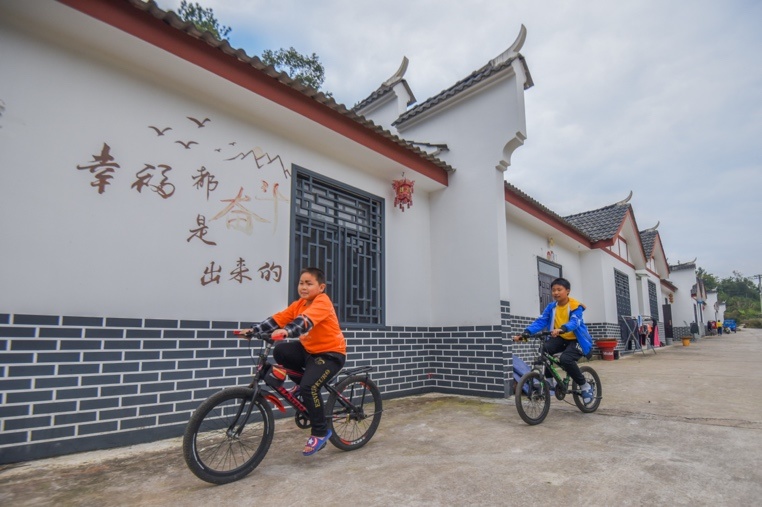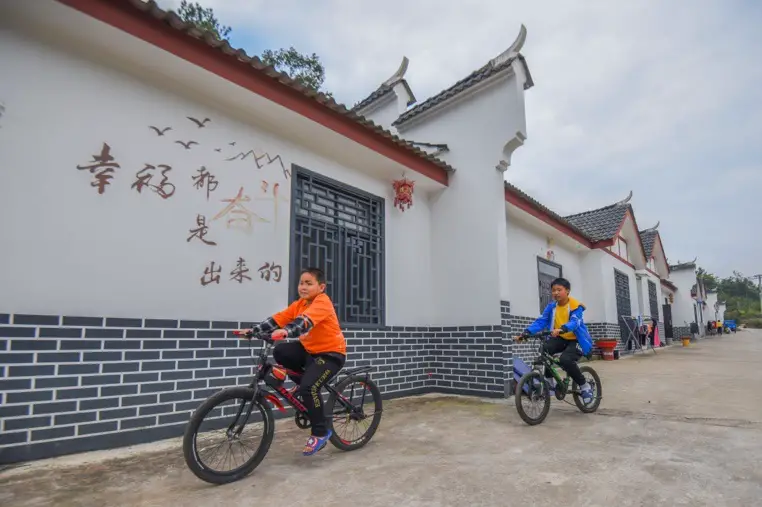By Li Xinping, People's Daily

Children ride bikes in front of the houses in a resettlement site in Xiejiaping Tujia ethnic township, Songzi, central China's Hubei province, October 11. (Photo by Huang Zhigang/People's Daily Online)
In Shibadong village, Huayuan county of central China's Hunan province, Shi Quanyou, a local resident, has been operating an agritainment resort in the picturesque village and marched toward prosperity step by step.
In Baqiu township, Xiajiang county, east China's Jiangxi province,More than 5,000 middle-and low-income families who used to live in shanties now have moved to spacious new houses.
In the brand-new teaching buildings in Mashu township, Qiaojia county, southwest China's Yunnan province, students read aloud happily in classrooms surrounded by lush mountains and lucid waters.
Chinese people have enjoyed a more and more prosperous life, which could be seen from their high-definition 4K TVs with large screens, double-door and high-capacity refrigerators and washing machines with sterilization and drying functions.
More and more residents have purchased dishwashers and robot mops to liberate hands, and more homes in the country have been equipped with air and water purifiers as people pursue a healthier lifestyle.
In addition, Chinese people have rapidly growing choices for clothes and are enjoying food from all over the world.
During China's 13th Five Year Plan (2016-2020), the per capita disposable income of Chinese residents rose from 23,800 yuan (about $3,557) in 2016 to 30,700 yuan in 2019.
The growth rate was faster than the average annual growth rate of per capita GDP in the same period.
As people’s income increases, they have seen a significant improvement in the quality of life.
In 2019, the Engel coefficient for Chinese residents dropped to 28.2 percent, marking the eighth consecutive year of decline. The figure has met the criterion for a “wealthy” living standard outlined by the United Nations (UN).
Since the 18th National Congress of the Communist Party of China (CPC) held in 2012, the CPC Central Committee has put poverty alleviation in a prominent place of state governance, and carried out a round of poverty eradication with unprecedented intensity, scale, and impact.
More and more poverty-stricken villagers in China have got rid of poverty and embraced a better life.
In 2019, registered poor population in China was reduced to 5.51 million, compared with 55.75 million in 2015 and the incidence of poverty fell from 5.7 percent to 0.6 percent during the period.
China has achieved decisive results in the fight against poverty.
The country aims to lift all poor rural residents living below the current poverty line and all poor counties out of poverty by the end of this year, which will be a miracle created by China in the history of human's fight against poverty.
Hundreds of millions of children in China have equal access to high-quality education and everyone has an opportunity to pursue a splendid life.
Compulsory education has seen a narrower gap between urban and rural areas; students from poor families have been guaranteed equal right to education; special education has secured rapid and sound growth.
In 2019, 94.8 percent of the students enrolled eventually completed their nine-year compulsory education.
The attendance rate for nine-year compulsory education in the country surpassed the average level of high-income countries. Gross enrollment ratio in China’s senior high schools rose to 89.5 percent, above the average level of medium-high income countries.
Meanwhile, China has established the world's largest higher education system with a gross enrollment ratio of 51.6 percent.
By involving all residents in its health development, China has tried to ensure that everyone enjoys the rights to medical care and health insurance. As the country continues to increase investment in health, the proportion of individual health expenditure in the nation's total continues to decrease.
A hierarchical medical system has been implemented comprehensively in China and more and more residents have signed up family doctors. The integration of the Internet into the medical field has made medical services more efficient and convenient.
As of the end of 2019, China had established the world's largest basic medical insurance network. More than 1.35 billion people had been covered by the network, accounting for over 95 percent of the entire Chinese population.
Last year, the average life expectancy of Chinese residents increased to 77.3 years, and the infant mortality rate of the country dropped to 5.6 per 1,000.
At the same time, the number of beds in medical and health institutions across the country exceeded 8.8 million, 2.8 times that of the year 2000.
Instead of simply providing residents with a house to live in, China has helped more and more people live in a decent and comfortable house.
By rebuilding shanty areas, constructing public rental houses, and renovating dilapidated houses in rural areas, China has made it possible for urban residents on subsistence allowance and low income as well as poor villagers to live in a safe house.
During the 13th Five Year Plan, the per capita living space of urban and rural residents in China has greatly increased. So has the quality of housing.
In 2019, the per capita floor area of urban residents was 39.8 square meters, an increase of 62.1 percent over 2002, while the per capita floor area of rural residents reached 48.9 square meters, 97.2 percent more than that in 2000.
During the 13th Five Year Plan, China has made steady progress in ensuring people's access to childcare, education, employment, medical services, elderly care, housing, and social assistance.
Guided by the vision of innovative, coordinated, green, open and inclusive development, the country has constantly raised people’s sense of gain, happiness and security, and steadily embarked on a road toward a moderately prosperous society in all respects.
In Baqiu township, Xiajiang county, east China's Jiangxi province,More than 5,000 middle-and low-income families who used to live in shanties now have moved to spacious new houses.
In the brand-new teaching buildings in Mashu township, Qiaojia county, southwest China's Yunnan province, students read aloud happily in classrooms surrounded by lush mountains and lucid waters.
Chinese people have enjoyed a more and more prosperous life, which could be seen from their high-definition 4K TVs with large screens, double-door and high-capacity refrigerators and washing machines with sterilization and drying functions.
More and more residents have purchased dishwashers and robot mops to liberate hands, and more homes in the country have been equipped with air and water purifiers as people pursue a healthier lifestyle.
In addition, Chinese people have rapidly growing choices for clothes and are enjoying food from all over the world.
During China's 13th Five Year Plan (2016-2020), the per capita disposable income of Chinese residents rose from 23,800 yuan (about $3,557) in 2016 to 30,700 yuan in 2019.
The growth rate was faster than the average annual growth rate of per capita GDP in the same period.
As people’s income increases, they have seen a significant improvement in the quality of life.
In 2019, the Engel coefficient for Chinese residents dropped to 28.2 percent, marking the eighth consecutive year of decline. The figure has met the criterion for a “wealthy” living standard outlined by the United Nations (UN).
Since the 18th National Congress of the Communist Party of China (CPC) held in 2012, the CPC Central Committee has put poverty alleviation in a prominent place of state governance, and carried out a round of poverty eradication with unprecedented intensity, scale, and impact.
More and more poverty-stricken villagers in China have got rid of poverty and embraced a better life.
In 2019, registered poor population in China was reduced to 5.51 million, compared with 55.75 million in 2015 and the incidence of poverty fell from 5.7 percent to 0.6 percent during the period.
China has achieved decisive results in the fight against poverty.
The country aims to lift all poor rural residents living below the current poverty line and all poor counties out of poverty by the end of this year, which will be a miracle created by China in the history of human's fight against poverty.
Hundreds of millions of children in China have equal access to high-quality education and everyone has an opportunity to pursue a splendid life.
Compulsory education has seen a narrower gap between urban and rural areas; students from poor families have been guaranteed equal right to education; special education has secured rapid and sound growth.
In 2019, 94.8 percent of the students enrolled eventually completed their nine-year compulsory education.
The attendance rate for nine-year compulsory education in the country surpassed the average level of high-income countries. Gross enrollment ratio in China’s senior high schools rose to 89.5 percent, above the average level of medium-high income countries.
Meanwhile, China has established the world's largest higher education system with a gross enrollment ratio of 51.6 percent.
By involving all residents in its health development, China has tried to ensure that everyone enjoys the rights to medical care and health insurance. As the country continues to increase investment in health, the proportion of individual health expenditure in the nation's total continues to decrease.
A hierarchical medical system has been implemented comprehensively in China and more and more residents have signed up family doctors. The integration of the Internet into the medical field has made medical services more efficient and convenient.
As of the end of 2019, China had established the world's largest basic medical insurance network. More than 1.35 billion people had been covered by the network, accounting for over 95 percent of the entire Chinese population.
Last year, the average life expectancy of Chinese residents increased to 77.3 years, and the infant mortality rate of the country dropped to 5.6 per 1,000.
At the same time, the number of beds in medical and health institutions across the country exceeded 8.8 million, 2.8 times that of the year 2000.
Instead of simply providing residents with a house to live in, China has helped more and more people live in a decent and comfortable house.
By rebuilding shanty areas, constructing public rental houses, and renovating dilapidated houses in rural areas, China has made it possible for urban residents on subsistence allowance and low income as well as poor villagers to live in a safe house.
During the 13th Five Year Plan, the per capita living space of urban and rural residents in China has greatly increased. So has the quality of housing.
In 2019, the per capita floor area of urban residents was 39.8 square meters, an increase of 62.1 percent over 2002, while the per capita floor area of rural residents reached 48.9 square meters, 97.2 percent more than that in 2000.
During the 13th Five Year Plan, China has made steady progress in ensuring people's access to childcare, education, employment, medical services, elderly care, housing, and social assistance.
Guided by the vision of innovative, coordinated, green, open and inclusive development, the country has constantly raised people’s sense of gain, happiness and security, and steadily embarked on a road toward a moderately prosperous society in all respects.
 Menu
Menu
 China makes sure everyone shares fruits of development during 13th Five-Year Plan
China makes sure everyone shares fruits of development during 13th Five-Year Plan
















